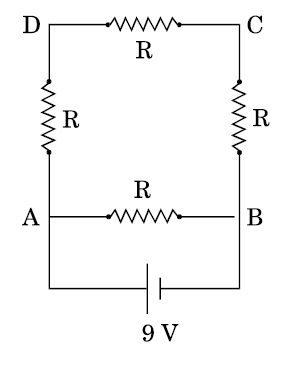Read carefully!
A resistance wire is bent in the form of a square. A source of emf is connected across one of its sides. If the wire is stretched uniformly to double the length and once again the same cell is connected in same way, across one side of the square formed, what will now be the potential difference across one of its diagonals?

The answer is 6.
This section requires Javascript.
You are seeing this because something didn't load right. We suggest you, (a) try
refreshing the page, (b) enabling javascript if it is disabled on your browser and,
finally, (c)
loading the
non-javascript version of this page
. We're sorry about the hassle.
Since the wire has a uniform cross-sectional area, its resistance is proportional to length. Therefore, the 3 sides, A D , D C and C B equally divide 9 V, with each side 3 V, hence the diagonal which has two sides has a potential difference of 6 V,